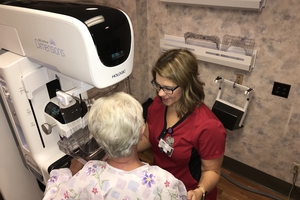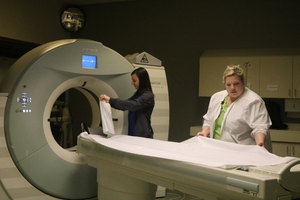Radiology
Compassionate, high-tech care close to home
Radiology services at OSF Saint Clare Medical Center offer a full range of diagnostic services that allow your care providers to properly diagnose illnesses or injuries or screen for multiple problems. OSF Saint Clare is proud to be a stroke certified hospital.
Services
 The radiologists are available 24 hours a day either on-site or by tele-radiology to provide timely and accurate results.
The radiologists are available 24 hours a day either on-site or by tele-radiology to provide timely and accurate results.
Radiology services employs more than a dozen registered technologists, including CT technologists, mammography technologists, sonographers, MRI technologists, and bone density technologists.
OSF Saint Clare radiology services offers a wide variety of services including diagnostic radiology, 64-slice CT scanner, ultrasound, digital mammography, nuclear medicine and open bore MRI.
X-ray
X-ray is the most commonly used and most longstanding form of medical imaging. An X-ray is a form of radiation that passes through your body to create an image. These images allow medical providers to view and assess fractured bones, look for injury or infection and locate foreign objects in the body.
X-ray images can be obtained while standing up or lying down. The registered technologist performing the x-ray will work with the patient to obtain the images that have been requested by their doctor or other medical provider. During certain X-ray exams, patients may be asked to hold their breath while the exposure is taken.
X-ray services are available 24 hours a day, seven days a week by an in-house technologist.
Fluoroscopy
Fluoroscopy, an upper or lower GI examination, is performed by a radiologist. A radiologist is a physician who specializes in the study of imaging exams. For both upper and lower GI exams, a technologist will gently position you on a special tilting table supporting a piece of equipment called a fluoroscope (an X-ray machine combined with a television screen).
For the upper GI, you will be asked to drink one or more liquid barium mixtures. For the lower GI, you will be given an enema. Your radiologist will watch the barium flow through your digestive tract. Digital photos will be taken of the areas your doctor wishes to study. X-ray images may also be obtained at the discretion of the radiologist.
Nuclear medicine
Nuclear medicine is the use of different isotopes used to study various organs. This allows radiologists to detect and diagnose a range of conditions, including heart abnormalities, liver disease and bone infections. Patients are administered a small amount of radioactive isotope via intravenous injection, orally or inhaled. The radioactivity is emitted from the patient and is detected by the camera to obtain the scan.
Nuclear medicine services are offered Monday-Friday from 8 a.m.-4 p.m. and on an on-call basis after-hours and weekends.
Magnetic Resonance Imaging (MRI)
Magnetic Resonance Imaging (MRI), uses a powerful magnetic field, radio-frequency pulses and a computer to produce detailed pictures of organs and structures inside the body. Due to the strong magnetic field, patients will be asked a series of questions by a qualified technologist to ensure all surgically implanted objects are safe to enter the magnet field.
During the MRI, you will lie on a table and will be requested to hold very still. The area of the body being studied is placed in the MRI machine. (We have the largest MRI opening available!) You will hear noises like loud tapping or knocking. Patients will be provided earplugs or headphones to listen to music.
An MRI is used to find problems, such as tumors, bleeding, injury, blood vessel problems or infection. An MRI may be done using contrast material to see abnormal tissue clearly. An MRI can be done for the head, blood vessels, abdomen, pelvis, bones and joints.
Ultrasound
Ultrasounds are performed by sonographers. The technologist will assist you onto an examination table, and a warm transmission gel will be applied to the area of your body that will be examined. The transducer sends a signal to an on-board computer that processes the data and produces the ultrasound image.
During the exam, you may be asked to hold your breath or be re-positioned by the sonographer. This is done so the sonographer can obtain the most accurate images. A diagnosis is made from the images obtained by the sonographer.
Ultrasounds are offered Monday-Friday from 8 a.m.-4 p.m. and on an on-call basis after hours and weekends.
Ultrasound vascular screenings can be done without an order from your medical provider. This screening uses ultrasound images to assess the abdominal aorta for an aneurysm and checks the lower legs for blood flow.
CAT or CT scan
 Computed Axial Tomography (CAT or CT) scan is an X-ray exam that combines X-rays with a powerful computer to obtain cross-sectional images of the body. Prior to your CT scan, the technologist will explain the procedure to you.
Computed Axial Tomography (CAT or CT) scan is an X-ray exam that combines X-rays with a powerful computer to obtain cross-sectional images of the body. Prior to your CT scan, the technologist will explain the procedure to you.
This is done to solicit your cooperation and put your mind at ease regarding what is taking place. Next you will be gently positioned. It is important that you hold very still during the exam because even the slightest movement during the split seconds of imaging can blur the picture.
You will then be moved into a donut-shaped opening in the scanner. The technologist will have you in full view at all times and will be in constant communication via a two-way microphone.
During this brief time, you may hear the whirring of the equipment as it produces the images. You may also feel slight movement of the table as it prepares for the next scan. For certain CT exams, you may be asked to drink barium or be given an IV injection. These contrast materials provide additional clarity for the radiologist diagnosing the exam.
CT exams are available 24 hours a day, seven days a week by an in-house technologist.
Digital mammography
Digital mammography is performed by a technologist registered in mammography who is highly skilled in providing detailed images of the breast. These images are used to detect cancer or other abnormalities. At OSF Saint Clare, we perform both screening and diagnostic mammograms. A provider’s order is not needed to schedule a screening mammogram.
Our 3D breast tomosynthesis capability provides additional clarity to the mammogram, by offering a three-dimensional view of the breast. This technology has been proven to detect breast cancer at least 15 months earlier as compared to conventional mammography.
How are images stored?
OSF Saint Clare Medical Center uses the Picture Archiving and Communications System (PACS) to obtain, view and distribute radiology images and accompanying data electronically. Benefits of this system include film cost savings since images are produced without the use of X-ray film and increased accuracy and timeliness of the radiologists’ reports.
All of the patients’ test results and information will be available to the provider within 48 hours after an exam is completed, and the results and information can be sent electronically to other hospitals.
Contact information
Phone: (815) 876-2291
To schedule a mammogram, call (815) 876-2050 or use OSF MyChart to schedule online.
